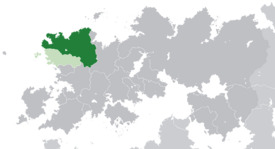North Ottonia
This article is incomplete because it is pending further input from participants, or it is a work-in-progress by one author. Please comment on this article's talk page to share your input, comments and questions. Note: To contribute to this article, you may need to seek help from the author(s) of this page. |
Federation of Ottonian Republics | |
|---|---|
|
Flag | |
| Motto: "Liberty, Equality, Solidarity." | |
| Anthem: "Onward, Ottonia!" | |
 Location of North Ottonia (dark green) – in Belisaria (dark grey) – claimed territory (light green) | |
| Capital | Innsboro |
| Largest city | Dunnmaar |
| Official languages | Allamunnic, Eonese |
| Ethnic groups | Allamunnae, Eoni |
| Demonym(s) | North Ottonian |
| Government | Federal Democratic Republic |
• Premier | Junn Andrsunn |
• Chancellor | Eleonur Hendrsunn III |
| Establishment | |
| September 21st, 1872 | |
| January 1st, 1922 | |
| September 21st, 1947 (ratified) | |
| Population | |
• 2020 estimate | 79,768,590 |
| GDP (PPP) | estimate |
• Total | USD$2.037 trillion |
• Per capita | USD$21,050 |
| Gini (2018) | 21.4 low |
| HDI (2018) | .704 high |
| Currency | Oto (NOØ) |
| Driving side | right |
| Calling code | +414 |
North Ottonia, officially the Ottonian Federal Republic, is a nation on the northwestern edge of the continent of Belisaria. It is bordered to the south by South Ottonia, Sudmark, and Orcot, to the east by Erishland and Skaldafen, and is neighbored across the North Thalassian Ocean by Ghant. The country was formed as a result of the Ottonian Civil War, arising in the zone controlled by the Republican government of the Ottonian Federation when the Partitioning of Ottonia took effect in 1922. In 1947, the existing Federal government was dissolved and the current government system was established in the New Foundation.
North Ottonia is a federalized democratic presidential republic, with some technocratic elements. Economically, North Ottonia adheres to a model of market socialism, which utilizes a mix of public and state ownership of enterprises alongside employee-owned and cooperatively-owned enterprises within a market system used to allocate goods and services. Although classification varies among political scientists throughout the world, those within the OFR typically categorize it as a democratic socialist state.
Geography
History
See also: History of Ottonia
North Ottonia's history as a distinct nation begins in 1915 with the outbreak of the Ottonian Civil War. The existing republican national government of The Ottonian Federation found itself under attack in an attempted coup by [royalist] forces seeking to create a national monarchy in imitation of the ancient Ottonian Empire. The civil war ended in the Partitioning of Ottonia in 1922 between the United Kingdom of Ottonia and the north, continuing now as the Republic of Ottonia. After seeing off an attempt by South Ottonia and Ghant to unify Ottonia under the monarchy's banner in the Great Ottonian War, the partitioning was more or less accepted as the ongoing state of affairs in Ottonia by 1943.
As the 1940's settled in, the devastation wrought by two bloody conflicts had taken a toll on the psyche of the North Ottonian people and on their economy. Despite his leadership in holding North Ottonia steady under the Ghantish and South Ottonian onslaught, Premier Otto Kraag found himself out of his depth in helming the massive recovery efforts needed to get the country back on its feet. As the recovery stagnated, demonstrations calling for a change in direction grew, reaching a crescendo in 1945 when a General Strike brought the country to a near standstill. Faced with the crisis, Kraag called for a constitutional convention to pen a companion update to the 1872 Treaty of Ottonia. However, as the convention dragged on for most of a year, it became increasingly clear that a new governing basis would be needed; with the guiding voices of Anessa Haaldur, Leogildo Garsia, Harald Baaltrsunn, Eleonur Hendrsunn,
Government
The FOR is a federalized democratic republic. The country is divided into the five constituent republics of North Ottonia: (from west to east) Jormundea, Eona, Corvaea, Bluwaald, and Skraelingia.
